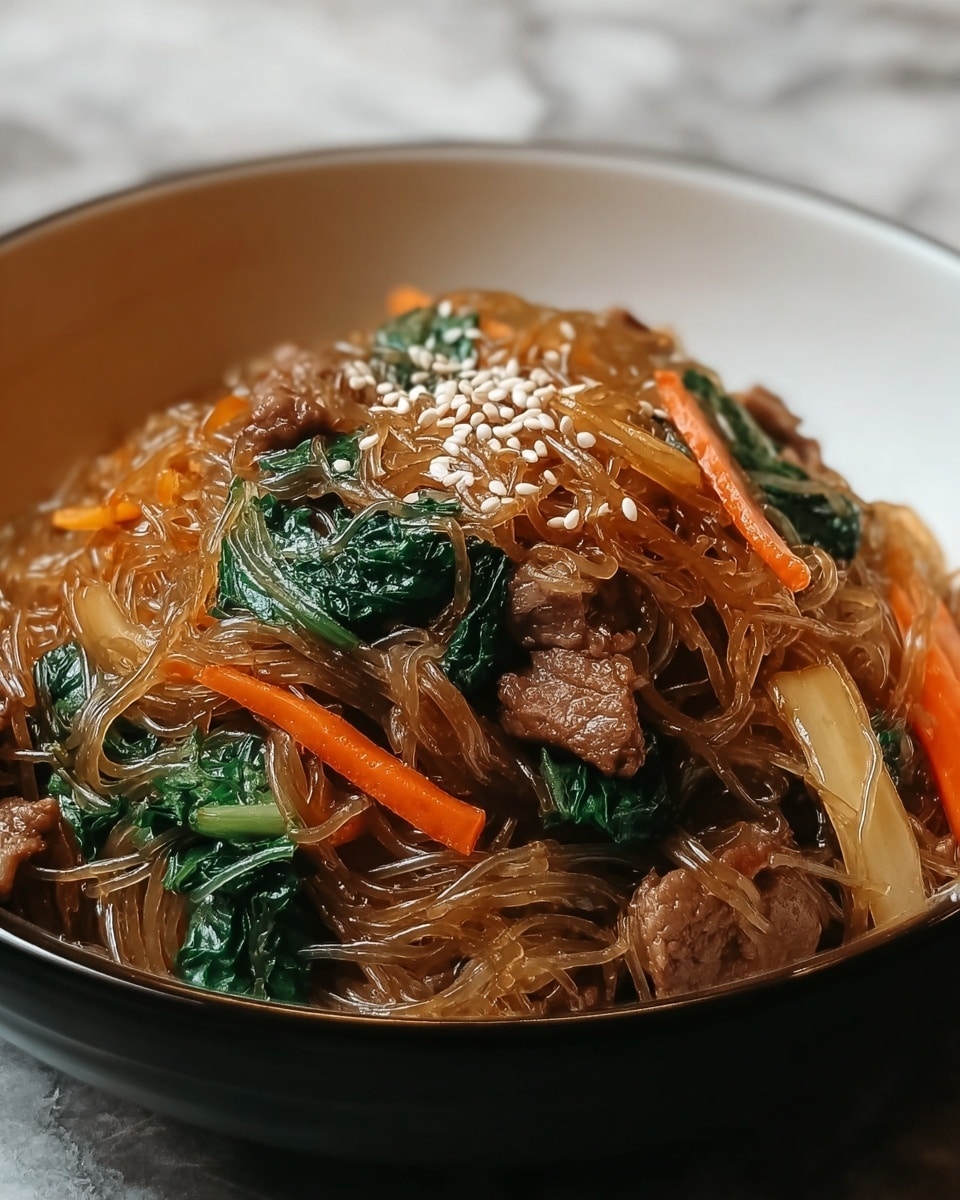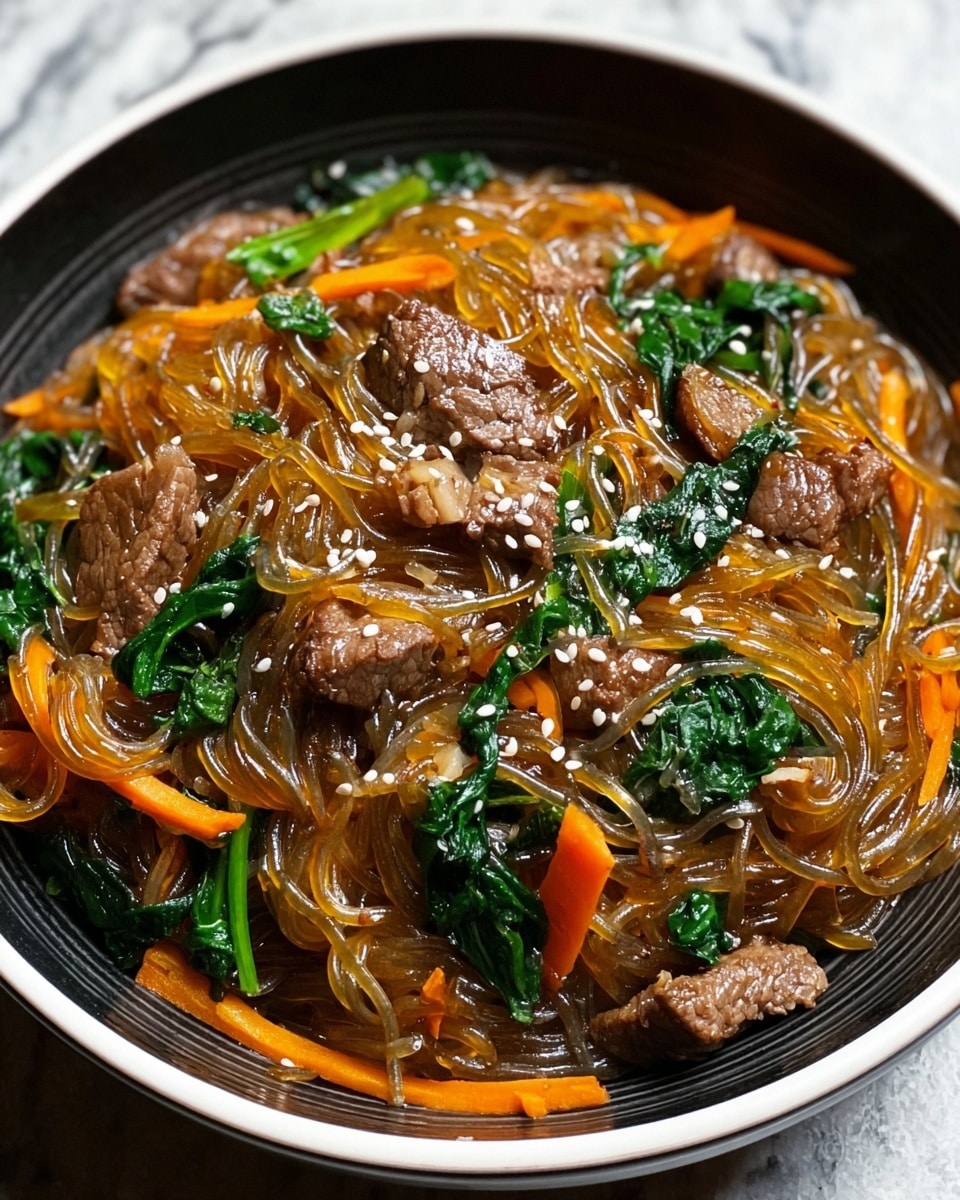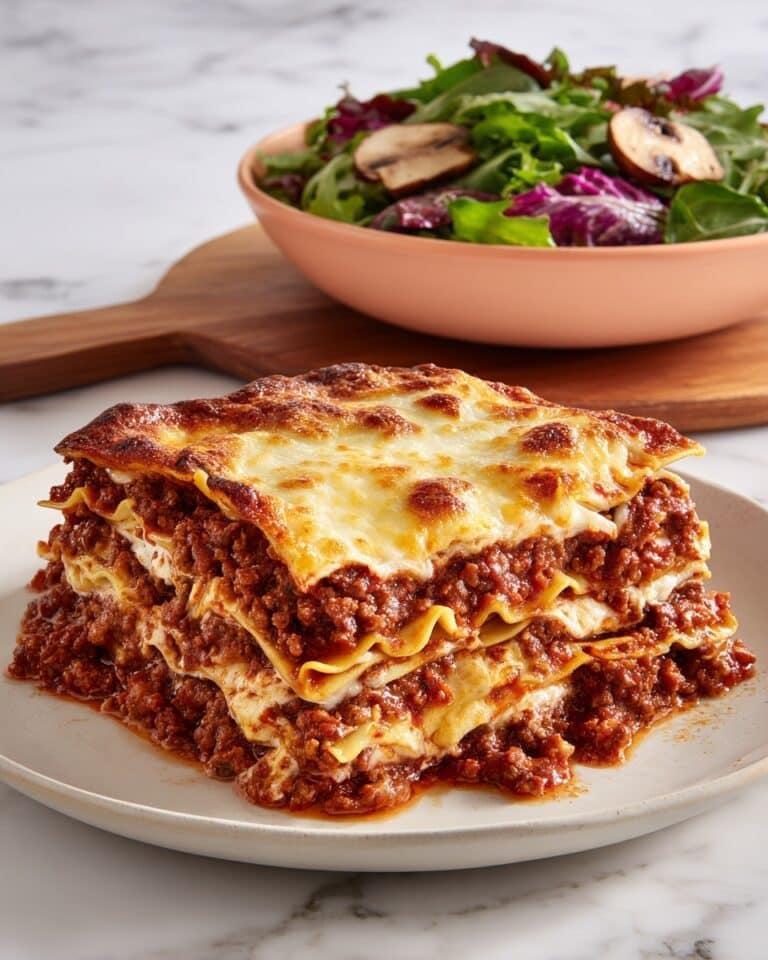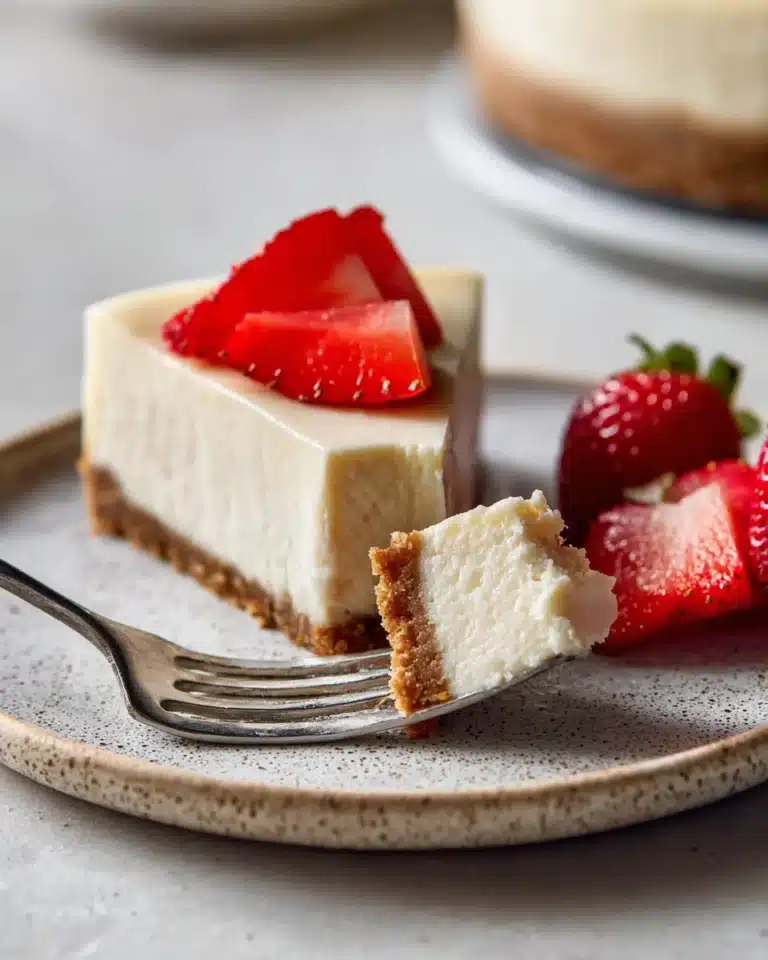If you’re looking for a vibrant, flavorful dish that’s both comforting and a feast for the eyes, then you’re going to fall in love with this Easy Korean Japchae with Beef and Vegetables Recipe. This classic Korean glass noodle stir-fry is packed with tender beef, crisp-tender vegetables, and a delightful sweet-savory sauce, making it a perfect meal for any occasion. The chewy sweet potato noodles soak up every bit of the rich seasoning, while the variety of colors and textures keeps every bite interesting. It’s a dish that not only tastes amazing but also brings a little cultural magic right to your own kitchen.
Ingredients You’ll Need
The beauty of the Easy Korean Japchae with Beef and Vegetables Recipe lies in its simple but essential ingredients. Each item contributes something special—whether it’s the silky noodles, the fresh crunch of veggies, or the savory-sweet balance of the sauce, every element works perfectly to create a harmonious dish.
- Thin-sliced beef (2 lb): Provides a rich, hearty flavor that pairs perfectly with the noodles and veggies.
- Korean sweet potato noodles (1 lb): These curious translucent noodles add an irresistible chewy texture and are naturally gluten-free.
- Carrots, julienned (3 medium): Add a fresh sweetness and nice crunch to the dish.
- Large white onion, thinly sliced (1): Offers a natural sweetness when sautéed, balancing the savory elements.
- Green onions, chopped (½ bunch): Bring a mild peppery flavor and brighten up the dish with their vibrant green color.
- Garlic cloves, minced (6): Infuse an essential depth of aroma and taste to the japchae.
- Spinach leaves (½ lb): Add a fresh and slightly earthy note while providing a lovely contrast in texture.
- Sesame oil (4 tbsp, divided): Delivers a nutty aroma that’s a signature in Korean cooking.
- Olive oil (1 tbsp): Used to sauté ingredients with a subtle flavor.
- Soy sauce (6 tbsp): The salty, umami backbone of the sauce—tamari works great for gluten-free needs.
- Brown sugar (3 tbsp): Adds a mellow sweetness that balances the savory aspects wonderfully.
How to Make Easy Korean Japchae with Beef and Vegetables Recipe
Step 1: Cook the Noodles
First things first, bring a large pot of water to a boil with a little drizzle of olive oil—this helps keep the noodles from sticking together. Add the Korean sweet potato noodles and cook them for about 5 to 6 minutes until they’re tender but still pleasantly chewy. Drain the noodles and set them aside. The texture here is key for that authentic japchae experience.
Step 2: Cook the Beef
Next, heat a skillet over high heat and cook the thinly sliced beef until it’s beautifully browned. While cooking, season the beef with half of the soy sauce, half of the sesame oil, and half of the brown sugar. This creates a fantastic caramelized coating that adds layers of flavor. Once done, set the beef aside to rest.
Step 3: Sauté the Vegetables
In a clean skillet, heat the remaining olive oil and toss in the julienned carrots and thinly sliced onions. Cook them until they soften up just right, releasing their natural sweetness. Now add the remaining soy sauce, sesame oil, and brown sugar to the pan, stirring to coat the veggies evenly. Mix in the minced garlic and chopped green onions, cooking for another minute so that their flavors really come alive.
Step 4: Add the Spinach
Finally, add the spinach leaves to the skillet and stir until they wilt down and become tender. This step adds a fresh green pop to the dish and keeps things balanced with a touch of earthiness among all the savory and sweet notes.
Step 5: Combine Ingredients
Now comes the fun part—combine the cooked beef and all the sautéed vegetables with the noodles in a large bowl. Toss everything together gently but thoroughly, ensuring the sauce and flavors are evenly distributed throughout. This is where your Easy Korean Japchae with Beef and Vegetables Recipe really comes to life as a vibrant harmony of tastes and textures.
Step 6: Serve
Serve your japchae warm, either on its own or garnished with some extra green onions if you want a fresh, colorful touch. The dish is perfect for a cozy weeknight dinner or impressing friends with a crowd-pleasing Korean classic.
How to Serve Easy Korean Japchae with Beef and Vegetables Recipe
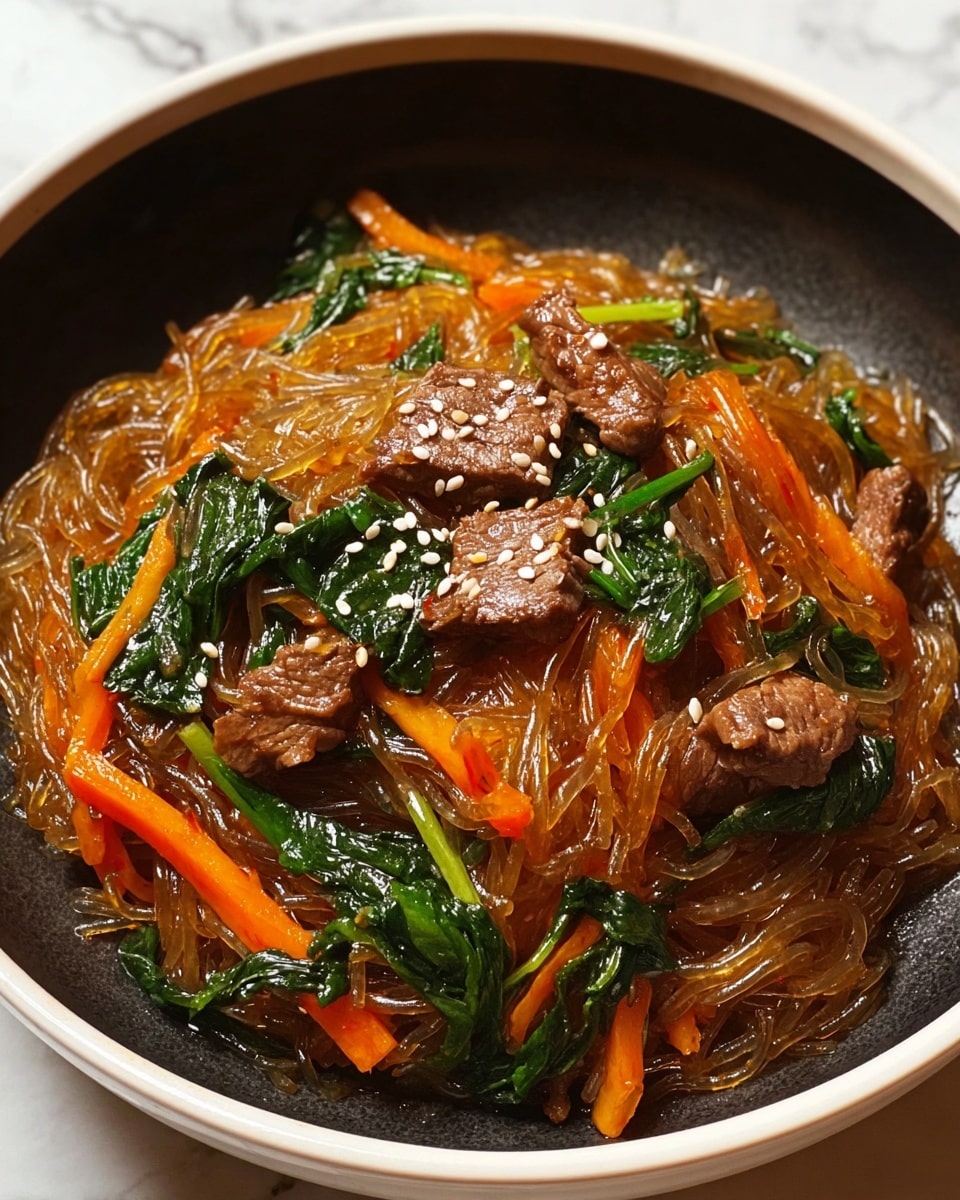
Garnishes
Sprinkling a handful of toasted sesame seeds or extra chopped green onions on top adds a lovely finishing touch with a bit of crunch and an appealing visual boost. For an extra pop of color and flavor, you can add finely sliced red chili or fresh herbs like cilantro.
Side Dishes
Japchae shines as the star of the meal, but it pairs wonderfully with other Korean favorites like kimchi, steamed rice, or a light cucumber salad. These sides complement the flavors without overpowering Japchae’s delicate balance.
Creative Ways to Present
For a festive touch, serve the japchae in individual lettuce cups for a fun wrap style, or layer it over a bed of steamed rice noodles for a fusion twist. You can also arrange it beautifully on a large platter, adding garnishes artistically for entertaining guests.
Make Ahead and Storage
Storing Leftovers
If you happen to have leftovers of this Easy Korean Japchae with Beef and Vegetables Recipe, store them in an airtight container in the refrigerator. It will stay fresh for up to 3 days, maintaining its delicious flavors, making it a perfect option for quick lunches or dinners later in the week.
Freezing
While japchae is best enjoyed fresh, you can freeze leftovers if needed. Place the cooled japchae in a freezer-safe container and freeze for up to 1 month. Thaw overnight in the fridge before reheating to preserve texture and taste as much as possible.
Reheating
To reheat, gently warm the japchae in a skillet over medium heat, adding a splash of water or a little sesame oil to keep the noodles from drying out. Stir occasionally until heated through. Avoid microwaving if you want to preserve the best texture.
FAQs
Can I substitute the beef with other proteins?
Absolutely! This Easy Korean Japchae with Beef and Vegetables Recipe is flexible; you can easily swap the beef for chicken, tofu, or shrimp depending on your preference or dietary needs. Just adjust cooking times accordingly.
What type of noodles are best for japchae?
Korean sweet potato noodles, also known as glass noodles or dangmyeon, are traditional for japchae. They have a unique chewy texture and absorb flavors beautifully. They’re typically found in Asian markets or online.
Is this recipe gluten-free?
To make it gluten-free, simply use tamari or a gluten-free soy sauce instead of regular soy sauce. The sweet potato noodles themselves are naturally gluten-free, so with that swap, you’re all set.
Can I make japchae vegetarian?
Yes, you can omit the beef and enhance the veggies, or add tofu for protein to keep it vegetarian. The sauce and noodles remain the same, so you won’t lose out on the flavors that make this dish special.
How long does japchae keep its texture after cooking?
Japchae is best eaten within a day or two for optimal texture, as the noodles can absorb too much sauce and become a bit mushy over time. However, proper storage and gentle reheating can help maintain its delightful chewiness for a couple of days.
Final Thoughts
Making this Easy Korean Japchae with Beef and Vegetables Recipe truly feels like inviting a piece of Korean home cooking into your kitchen. The blend of sweet, savory, and nutty flavors alongside the colorful medley of ingredients creates a dish that’s as satisfying to make as it is to eat. Whether you’re sharing it with loved ones or savoring a cozy solo meal, I hope you enjoy every delicious bite as much as I do. Give it a try—you won’t be disappointed!
Print
Easy Korean Japchae with Beef and Vegetables Recipe
- Prep Time: 15 minutes
- Cook Time: 20 minutes
- Total Time: 35 minutes
- Yield: 4 to 4 servings
- Category: Main Course
- Method: Stovetop
- Cuisine: Korean
Description
Japchae is a classic Korean stir-fried noodle dish made with sweet potato glass noodles, tender beef, and a colorful mix of vegetables like carrots, onions, and spinach. It’s flavored with a savory-sweet sauce of soy, sesame oil, and brown sugar, creating a wonderfully balanced and satisfying dish perfect for lunch or dinner.
Ingredients
Protein
- 2 lb thin-sliced beef (or substitute with chicken, tofu, or shrimp)
Noodles
- 1 lb Korean sweet potato noodles (glass noodles)
Vegetables
- 3 medium carrots, julienned
- 1 large white onion, thinly sliced
- ½ bunch green onions, chopped
- 6 garlic cloves, minced
- ½ lb spinach leaves
Oils & Sauces
- 4 tbsp sesame oil (divided)
- 1 tbsp olive oil
- 6 tbsp soy sauce (or tamari for gluten-free)
- 3 tbsp brown sugar
Instructions
- Cook the Noodles: Bring a large pot of water to a boil with a drizzle of olive oil to prevent sticking. Add the Korean sweet potato noodles and cook for 5-6 minutes until tender but firm. Drain the noodles well and set aside.
- Cook the Beef: Heat a skillet over high heat and cook the thin-sliced beef until browned through. While cooking, season the beef with half the soy sauce, half the sesame oil, and half the brown sugar, allowing the flavors to infuse. Once cooked, remove the beef from the heat and set aside.
- Sauté the Vegetables: In a separate skillet, heat the remaining olive oil over medium heat. Add the julienned carrots and thinly sliced onions, cooking until they become soft and fragrant. Stir in the remaining soy sauce, sesame oil, and brown sugar. Add the minced garlic and chopped green onions and sauté for another minute to combine the flavors well.
- Add the Spinach: Toss in the spinach leaves with the vegetables and cook, stirring frequently, until the spinach is just wilted and tender.
- Combine Ingredients: In a large mixing bowl, combine the cooked noodles, sautéed vegetables with spinach, and cooked beef. Toss everything thoroughly to evenly distribute the sauce and ingredients.
- Serve: Serve the Japchae warm, optionally garnished with extra chopped green onions for added freshness and color.
Notes
- You can substitute beef with chicken, tofu, or shrimp for a variation.
- Using tamari instead of soy sauce makes the dish gluten-free.
- Adjust the brown sugar amount to your preferred level of sweetness.
- Be sure not to overcook the noodles; they should remain slightly chewy.
- For a vegetarian version, omit the beef and use tofu as protein.
- Japchae is best served fresh but can be stored refrigerated for up to 2 days.

